7 Common Peace Lily Problems And How To Fix Them

This post follows our research editorial guidelines.

Pretty as a princess, and just as fussy, the peace lily (Spathiphyllum) has a reputation for trouble. From flowers that turn green to sudden brown leaves, dramatic drooping, and more, the peace lily is going to get your blood pressure racing.
Here’s a complete list of the more common problems a peace lily will pout over, and what you can do to bring this darling back to living their best life.

Table of Contents
1. Peace lily droops or wilts
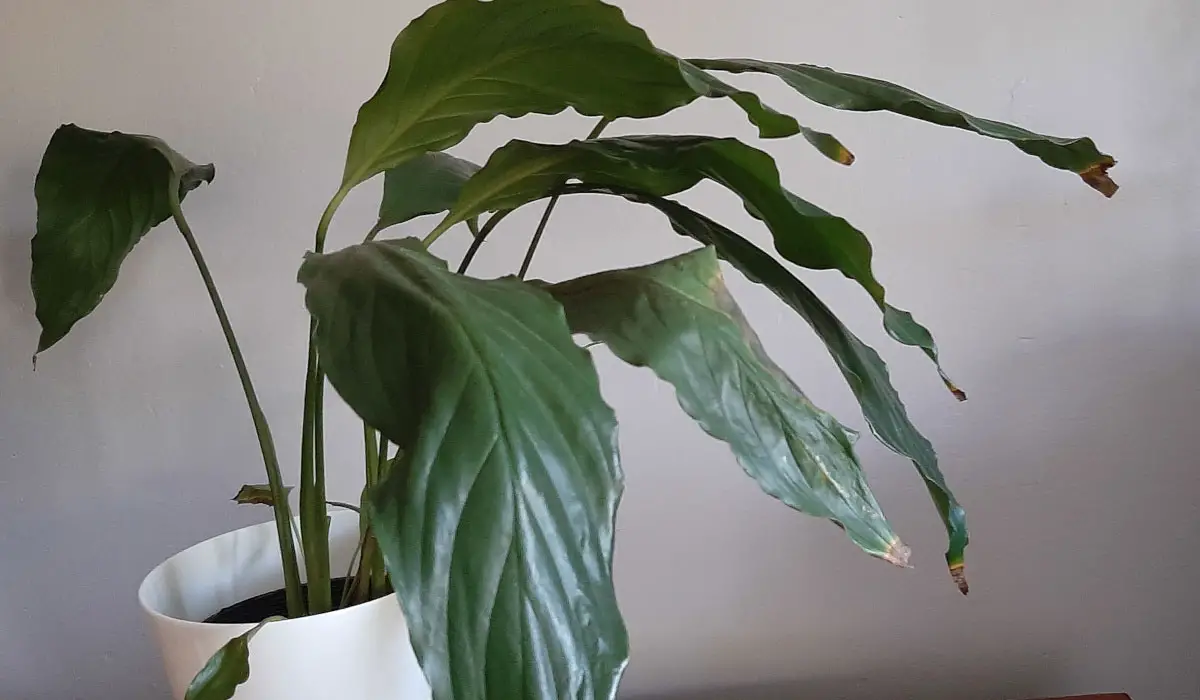
Your Peace Lily is Under-watered
Peace lilies aren’t shy about communicating their thirst. Too little water will cause the leaves to droop. Give the lily a drink and watch it pop back up like it’s raised from the dead.
Watering from below is the most efficient method to get a drooping peace lily back to its best self. This involves placing the entire pot in a basin of clean water. Water seeps up into the soil through the drainage holes and rehydrates the plant from the root system up.
In the future, water your peace lily before you notice your plant wilting. You want to keep it well hydrated but not sodden.
Your Peace Lily is Over-watered
Very often a plant with too much water shows the same symptoms as one with too little. If your Spathiphyllum is still drooping after each watering, it’s likely they have too much water and not too little.
Overwatered plants also develop yellow leaves and typically have soil that’s constantly wet. Watch for fungus gnats – they’re the annoying little heralds of soil that’s too soggy. If you’ve caught it before the leaves are turning yellow, letting the plant dry out before you water again should suffice.
If you’re looking for some quick tips to help your struggling peace lily check out this short video compilation of problems and fixes.
You Peace Lily Needs More Light
Peace lilies are fantastic houseplants for gloomy corners. But ‘low light’ is not synonymous with ‘no light’. The lush green leaves of your peace lily require light to photosynthesize and produce food for the plant. No light means no food.
This is easy to correct – move your plant to an area with more light. While bright indirect light is best for growth, somewhere with enough natural light to throw a shadow will do.
2. Peace Lily plant has Yellow Leaves
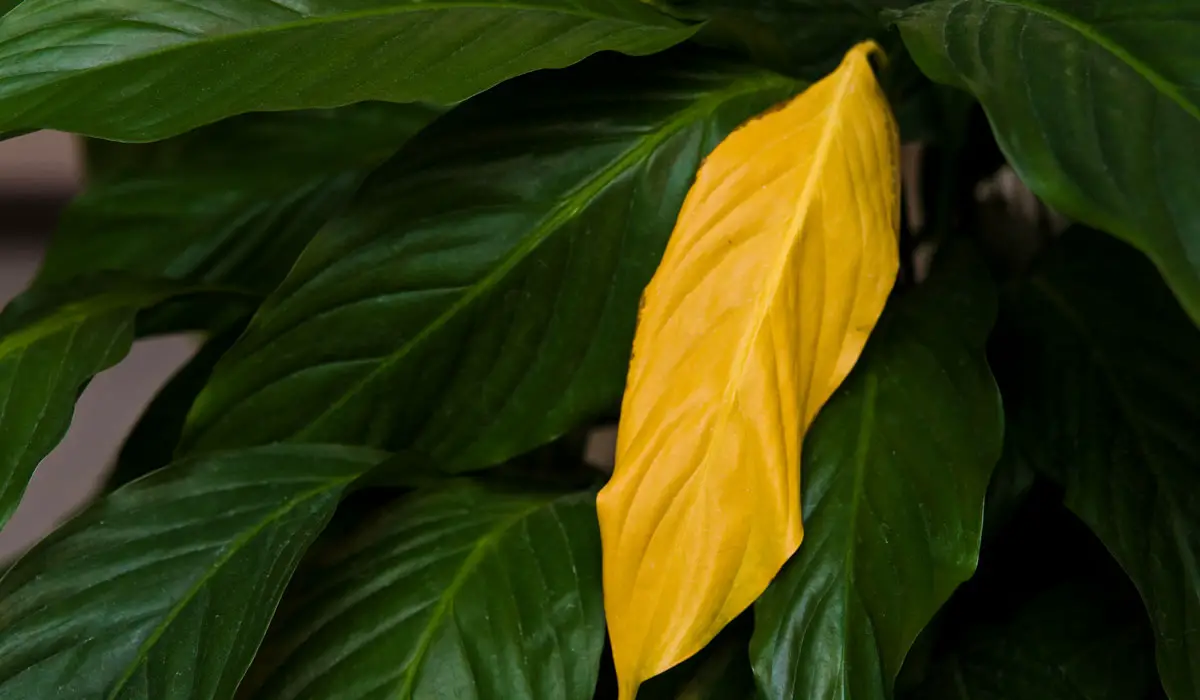
Your Peace Lily is Overwatered
Again, overwatering underpins the most common problems with peace lilies. You don’t need to give your plant water every day.
As far as treatment goes, one or two yellow leaves suggest you can let the overwatered peace lily plant dry out. More than one, especially if the peace lily wilts and has consistently droopy leaves, suggests root rot. Check the peace lily’s roots for damage. Roots that are brown, black, or orange need to be treated. Remove damaged roots and repot in fresh soil and a clean pot. I’ve also had good results dusting with cinnamon powder before potting up. It’s an effective anti-fungal agent and helps ailing peace lilies grow new roots.
The Leaves are Aging Naturally
All good things must come to an end, and it’s no different for Spathiphyllum leaves. They will become crisp and slowly lose their color as they age. They will dry from the tip of the leaves inwards, turning yellow and eventually brown.
So long as the rest of the plant’s leaves are healthy there’s nothing to worry about. You can cut it off the plant by snipping the stem an inch or two above the soil and discard.
3. Peace Lily Has Brown Leaf Tips
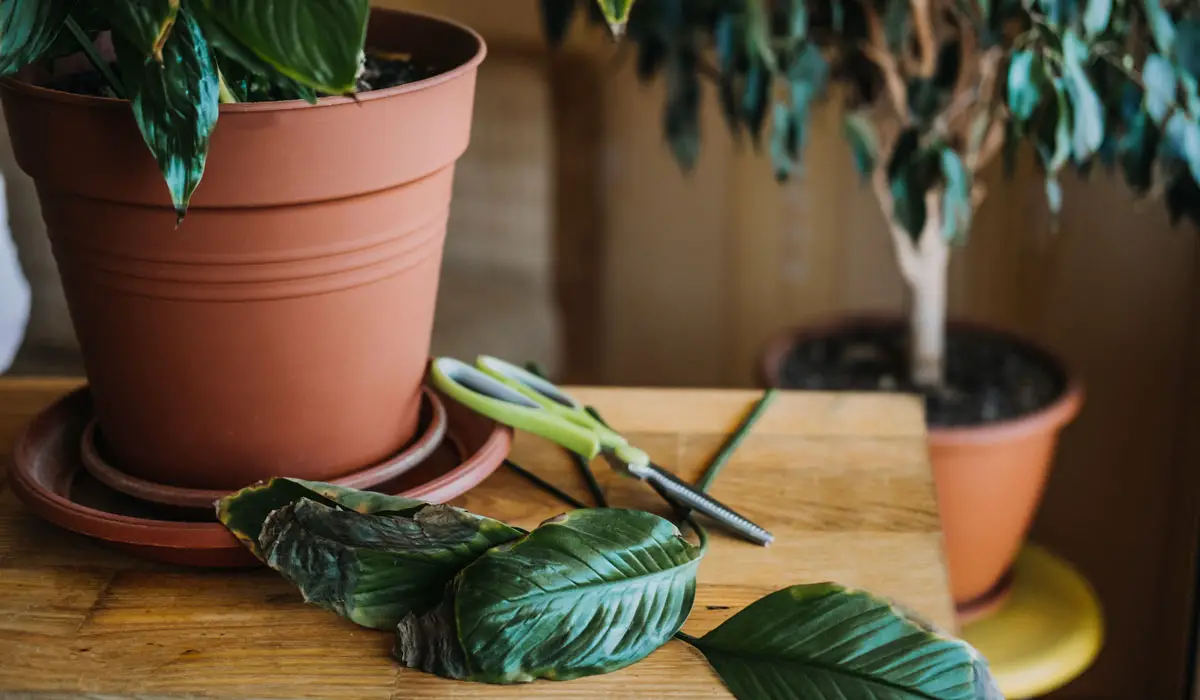
Your Peace Lily wants More Humidity
Peace lilies are tropical plants and need around 50% atmospheric humidity or higher. When the air is too dry, the leaves dry out They turn brown at the tips, and often the leaves will develop a crispy edge, too.
You can improve the humidity around your Spathiphyllum by grouping it with other humidity-loving plants. You can also pop your plant on a tray filled with river stones and water. As the water evaporates it creates a small area of gentle humidity around your plant. A more definite choice is an electric humidifier.
Your Peace Lily Requires Reliable Watering
Erratic soil moisture affects peace lily leaves even after you give your peace lily a drink. It shows first in slow growth, but this is easy to miss in a plant like a peace lily. More obvious are the brown tips and edges that show when they are water stressed.
To prevent this, water your plant more regularly. Try and avoid dramatic wilting in the first place, as the damage to the plant can’t be reversed.
Peace Lily has Too much Fertilizer
Peace lilies are light feeders, and too much fertilizer can damage them. An over-fertilized peace lily can’t use the excess. It collects in soil and causes brown tip problems in the leaves. They crisp up and appear almost burned.
To correct this problem, flush the soil with lots of clean water. Place the plant under a tap or hose, filling the pot until water flows freely from the bottom. Leave the water to settle for five to ten minutes to dissolve any remaining salts, then repeat the process.
Fertilize your peace lily in the spring and summer, maybe once every other month. A half-strength dose of liquid fertilizer is best.
4. Brown Leaves on Peace Lilies

Your Peace Lily is Overwatered
If you don’t treat your overwatered Spathiphyllum when the leaves first start to yellow, the leaves may turn brown and die. You’ll need to see if your plant has much root mass left to save by this point.
Check the roots for rot and repot as outlined above. Remove the dying leaves as well as the damaged roots. It’s less common for them to pull through once the damage is severe, however.
Your Peace Lily is Watered Infrequently
Feast or famine is no way to water peace lilies. If your plant is drooping between each and every watering, and the leaves have lots of brown tips, it’s almost inevitable. The stress alone will cause peace lily leaves to turn brown.
Be sure to keep your soil well hydrated. Don’t let it dry out, and don’t overcompensate once you notice your peace lily yearns for a drink.
The Peace Lily has Too Much Light
Too much light can overwhelm the leaves and cause peace lilies damage. Injured leaves bleach to yellow or pale tan before becoming brown. Sunburn always happens on the side of the plant that faces the light. Other common causes of brown leaves result in an even scattering of dead leaves across the plant. Sunburn however only happens where the sun is!
To correct it, move your plant away from direct sunlight and relocate to an area lit bright but indirect light instead.
The Leaves are Aging Naturally
As mentioned above, leaves have a finite lifespan. Old age causes brown leaves to develop at the outer, older part of the plant. If the plant is producing new leaves and has no other issues, it’s safe to just discard the leaf and move on.
5. Peace Lily Leaves Turning Black
Your Peace Lily is Damaged
Frost damage, heat damage and physical impact can cause injuries to the leaf that eventually turn black. A frozen leaf flushes bright green before blackening. The damaged tissue softens and rots away.
Heat is much the same – a leaf that rests against a radiator for example is essentially cooked. It will darken just the same as spinach in a frying pan. A leaf that’s crushed, twisted, or otherwise bruised is likely to turn black before it dries out and dies.
Once leaves are black it’s over for them, so prevention is key. Frost damage frequently comes from contact with cold window panes. Keep the lily away from fireplaces, radiators, or heaters, too.
6. Green Flowers on peace lily
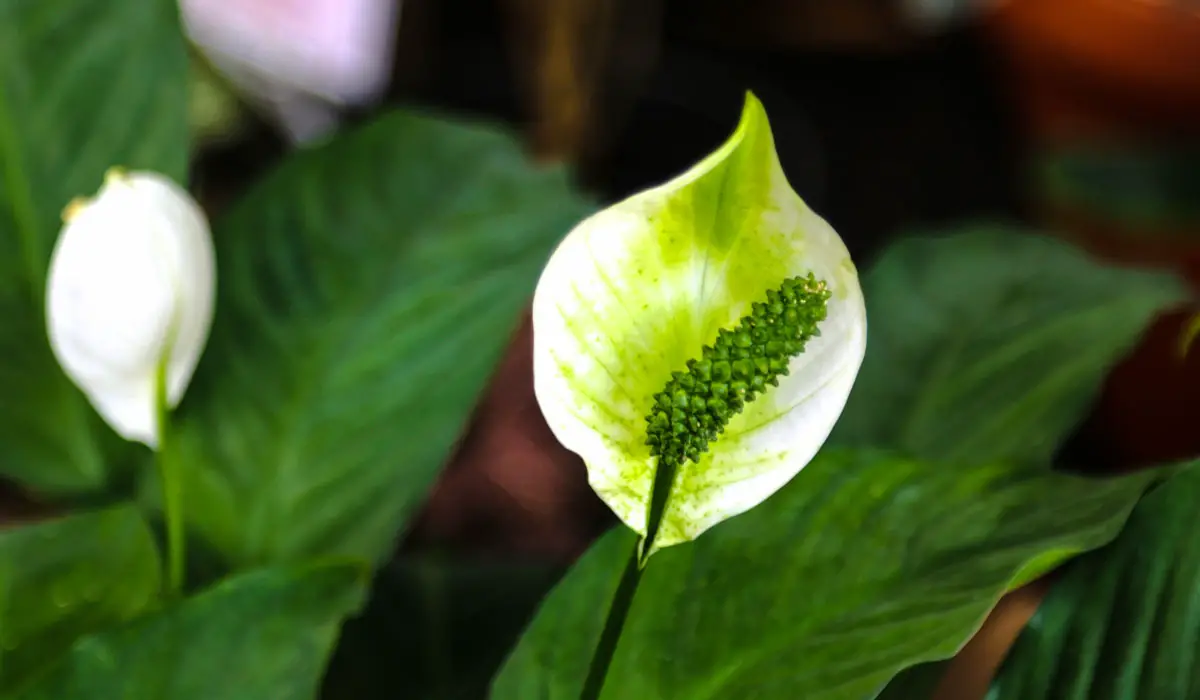
The Flowers are Aging Gracefully
What we think of as a lily flower is actually a far more remarkable structure. The rigid heart of the lily is a tightly cluster of flowers called a spadix. The large white ‘petal’ that wraps around it so elegantly is in fact a special leaf called a spathe.
As the spathe ages, it’s common for a little green to sneak back in. This is perfectly normal and nothing to fuss about. If you don’t like the hue you can cut it free with clean scissors at the base.
Your Peace Lily Needs More Light
Conversely, if your lily has lots of flowers but not enough light, those white spathes will turn a productive shade of green. They remember being leaves, and when the plant needs more production they’ll turn green.
Move your peace lily to an area with brighter light. Avoid direct sun, however, as that can burn the leaves and cause them to turn brown.
7. Peace lily flowers dying
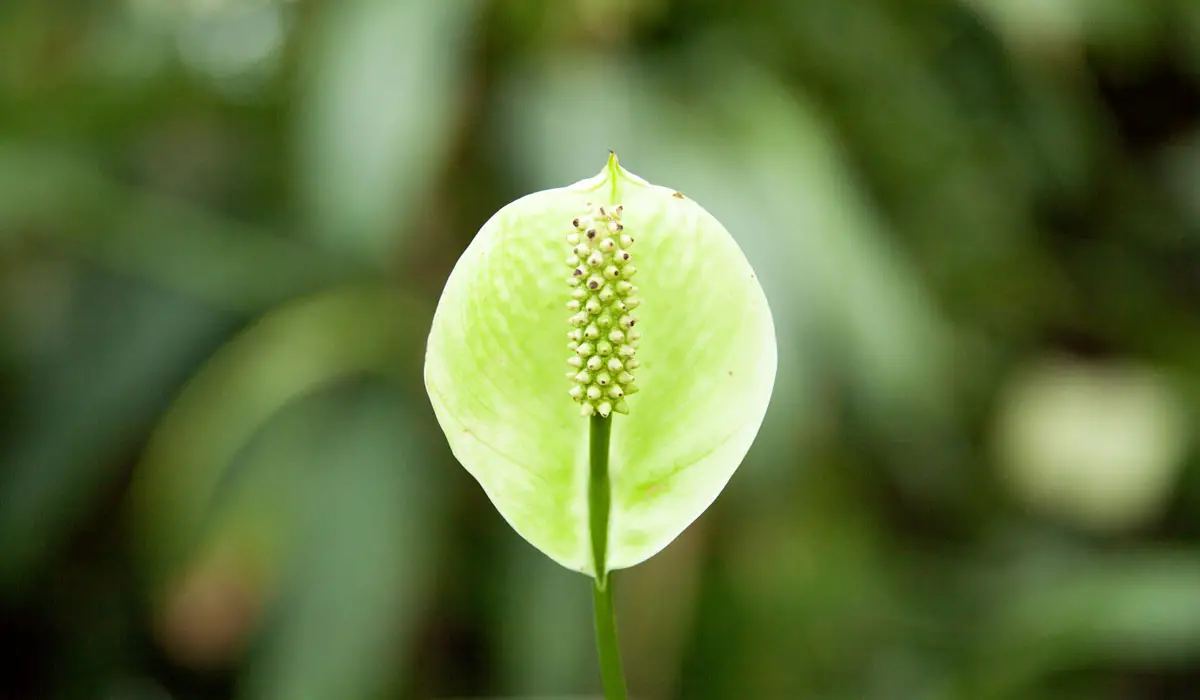
The Flowers are Old
Like the leaves, lily flowers have a limited time in which to shine. The flowers of the peace lily are tough and far more enduring than most, but even they will eventually wilt and die.
If the rest of the plant is looking fine, with lots of new growth and lush, glossy leaves, there’s nothing to worry about. Just trim the dying flower away and discard it.
Your Care Needs Improving
If flowers start to develop and then die before they open, it’s a sign there are inconsistencies in your care. The most common reasons are issues with water or light that is not enough to stop the rest of the plant from growing, but just enough to interfere with blooms.
To ensure your beautiful blooms stick around, ensure consistent levels of light, humidity, and soil moisture.
FAQ
Do peace lilies like to be root-bound?
Peace lilies do just fine when slightly rootbound. So long as there is space for water to drain, and enough material left to keep the roots hydrated, they can be allowed to pack out their pot before you move them.
Should brown bits be trimmed off of peace lily leaves?
There’s no harm in trimming dry leaf tips from your peace lily. While peace lilies are very resilient and will spring back once care improves, there’s no undoing damage.
To trim them, use clean scissors or shears and cut into the brown part of the leaf only. Cutting into green leaves will result in brown edges, so it’s best to cut to minimize damage to the leaf.
How do I get more peace lily flowers?
“To encourage peace lilies to bloom in the home, plants should be located in areas bright enough to read a newspaper. They should be kept away from cold drafts and maintained uniformly moist with fertilizer applied monthly during the spring and summer using one of the liquid houseplant fertilizers.”
Gerald Klingaman, Extension Horticulturist, University of Arkansas
Flowers on any indoor plant are a trophy awarded for consistent, high-quality care. The better you tend to your plant, the more flowers it will grow.
To grow peace lily blossoms, keep the plant warm. Temperatures between 24-30°C ( 75–85°F) are best. Maintain moist but not boggy soil. They need 50% atmospheric humidity or higher, and need bright but indirect light. Finally fertilize every other month during the growing season only.
Final thoughts
Even a healthy peace lily has the occasional leaf turning brown, or perhaps a day or two when the peace lily is still drooping after a good soak. It’s comforting to know if the problem with your plant is a common issue that’s easy to correct, or whether your peace lily might need more serious care. But once you learn how to keep your peace lily happy, it’ll reward you with years of crisp flowers and elegant leaves.

Before you go!
Why are my tomatoes growing black on the bottom?
Top 8 Great Elephant Ear Varieties – Rare and Common Types
Elephant Ear Turning Yellow, Brown, and Discolored
How Long Do Air Plants Live? What To Do During Your Plants Final Stage